

Définir une ontologie avec OWL. De nombreux langages informatiques sont apparus pour construire et manipuler des ontologies.
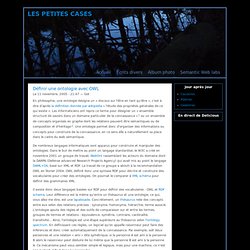
Dans le but de mettre au point un langage standardisé, le W3C a créé en novembre 2001 un groupe de travail, WebOnt rassemblant les acteurs du domaine dont la DARPA (Defense advanced Research Projects Agency) qui avait mis au point le langage DAML+OIL basé sur XML et RDF. Le travail de ce groupe a abouti à la recommandation OWL en février 2004. SKOS Simple Knowledge Organization System - home page. SKOS is an area of work developing specifications and standards to support the use of knowledge organization systems (KOS) such as thesauri, classification schemes, subject heading lists and taxonomies within the framework of the Semantic Web ...
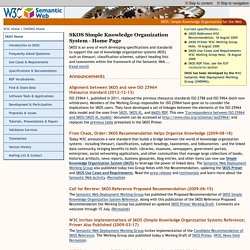
[read more] Alignment between SKOS and new ISO 25964 thesaurus standard (2012-12-13) ISO 25964-1, published in 2011, replaced the previous thesaurus standards ISO 2788 and ISO 5964 (both now withdrawn). Members of the Working Group responsible for ISO 25964 have gone on to consider the implications for SKOS users. They have developed a set of linkages between the elements of the ISO 25964 data model and the ones from SKOS, SKOS-XL, and MADS/RDF. Linked Geospatial Data 2014 Workshop, Part 1: Web Services or SPARQL Modeling? The W3C (World Wide Web Consortium) and OGC (Open Geospatial Consortium) organized the Linked Geospatial Data 2014 workshop in London this week.
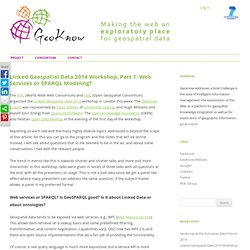
The GeoKnow project was represented by Claus Stadler of Universität Leipzig, and Hugh Williams and myself (Orri Erling) from OpenLink Software. The Open Knowledge Foundation (OKFN) also held an Open Data Meetup in the evening of the first day of the workshop. Reporting on each talk and the many highly diverse topics addressed is beyond the scope of this article; for this you can go to the program and the slides that will be online. Instead, I will talk about questions that to me seemed to be in the air, and about some conversations I had with the relevant people. The trend in events like this is towards shorter and shorter talks and more and more interaction.
S is for Semantics. CoursWebSem. Linked Data. Www.w3.org/2010/Talks/0322-egov-sandro/talk.pdf. Pub/DataTuesdayJan2012.pdf. IT (513) OpenCalais. Big Data: buzzword or revolution? What?
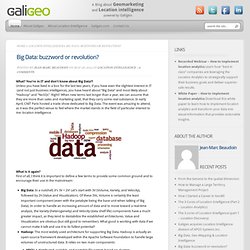
Publication des supports des présentations 2012. De retour de WebSem Pro 2012. Généralités web sémantique. Ordnance Survey Datasets. Launching a new Linked Data service. We’ll soon be launching the next iteration of our Linked Data Service at In preparation we have created a beta version ( which has been designed for you to have a play around, test and review against your current applications.
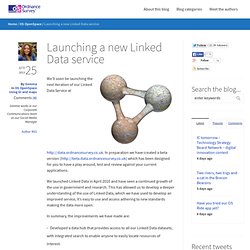
We launched Linked Data in April 2010 and have seen a continued growth of the use in government and research. This has allowed us to develop a deeper understanding of the use of Linked Data, which we have used to develop an improved service, it’s easy to use and access adhering to new standards making the data more open. In summary, the improvements we have made are: Developed a data hub that provides access to all our Linked Data datasets, with integrated search to enable anyone to easily locate resources of interest.Embedded OS OpenSpace maps to show the geographic location chosen.Separate datasets, which will allow you to narrow down your searches.
Web 3_0 - l’évolution vers le web sémantique: l’internet intelligent. List of Thousands of Public Data Sources. A website called BigML (for Big Machine Learning) has compiled a great list of freely available public data sources.
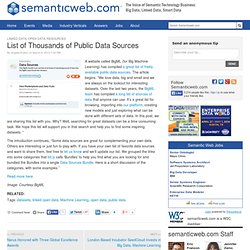
The article begins: “We love data, big and small and we are always on the lookout for interesting datasets. Over the last two years, the BigML team has compiled a long list of sources of data that anyone can use. It’s a great list for browsing, importing into our platform, creating new models and just exploring what can be done with different sets of data. In this post, we are sharing this list with you. Langages de communication et d'échange d'information sémantisée entre agents. Introduction to: Triplestores. Triplestores are Database Management Systems (DBMS) for data modeled using RDF.
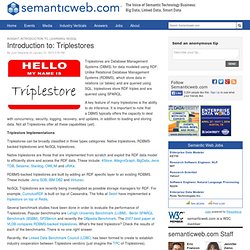
Unlike Relational Database Management Systems (RDBMS), which store data in relations (or tables) and are queried using SQL, triplestores store RDF triples and are queried using SPARQL. A key feature of many triplestores is the ability to do inference. It is important to note that a DBMS typically offers the capacity to deal with concurrency, security, logging, recovery, and updates, in addition to loading and storing data. Joinup. Blog Le thesaurus à l’ère du web sémantique. La norme ISO 25964, consacrée à la construction du thesaurus, va paraître en juin 2011.
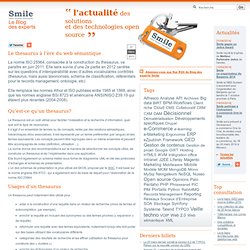
Elle sera suivie d’une 2e partie en 2012 centrée sur les questions d’interopérabilité avec d’autres vocabulaires contrôlés (thesaurus, mais aussi taxonomies, schéma de classification, référentiels pour le records management, ontologie, etc) Linked Data on the Web Workshop at WWW 2012. This year was the 5th version of the Linked Data on the Web Workshop co-located at the World Wide Web Conference going on in Lyon, France.

At this workshop, seven issues caught my attention: 1) Media: Yunja Li presented on Synote: Weaving Media Fragments and Linked Data. This is interesting for those who not only want to link to an entire video, but want to link to a part of a video at a specific interval of time, and also add metadata information about that. 2) NLP to Linked Data: How can we relate the results of different named entity extraction tools to Linked Data. Giuseppe Rizzo introduced their project, NERD, which is working on this area. Gestion de données à l'heure de la toile. Semantic Models for CDISC. Kerstin Forsberg has written an article discussing a presentation she and Frederik Malfait gave regarding the use of semantic models for CDISC-based standard and metadata management, pointing to case studies at AstraZeneca and Roche.
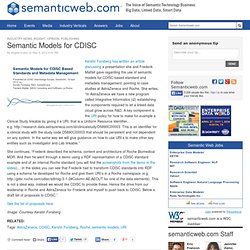
She writes, “In AstraZeneca we have a new program called Integrative Informatics (i2) establishing the components required to let a linked data cloud grow across R&D. A key component is the URI policy for how to make for example a Clinical Study linkable by giving it a URI, that is a Uniform Resource Identifier, e.g. This is an identifier for a clinical study with the study code D5890C00003 that should be persistent and not dependent on any system.
In the same way we will give guidance on how to use URI:s to make other key entities such as Investigator and Lab linkable.” She continues, “Frederik described the schema, content and architecture of Roche Biomedical MDR. See the list of proposals here. NoSQL. Un article de Wikipédia, l'encyclopédie libre. C News Archive: 2012 W3C. High Resolution Time, and Navigation Timing are W3C Recommendations 17 December 2012 The Web Performance Working Group has published two W3C Recommendations today. Navigation Timing. This specification defines an interface for web applications to access timing information related to navigation and elements.High Resolution Time. What is Linked Data. Level: introductory In the early 1990s there began to emerge a new way of using the internet to link documents together. It was called the World Wide Web.
What the Web did that was fundamentally new was that it enabled people to publish documents on the internet and link them such that you could navigate from one document to another. Part of Sir Tim Berners-Lee’s original vision of the Web was that it should also be used to publish, share and link data. This aspect of Sir Tim’s original vision has gained a lot of momentum over the last few years and has seen the emergence of the Linked Data Web. The Linked Data Web is not just about connecting datasets, but about linking information at the level of a single statement or fact. Introduction to the Semantic Web. Introduction The Semantic Web, Web 3.0, the Linked Data Web, the Web of Data…whatever you call it, the Semantic Web represents the next major evolution in connecting information.
It enables data to be linked from a source to any other source and to be understood by computers so that they can perform increasingly sophisticated tasks on our behalf. This lesson will introduce the Semantic Web, putting it in the context of both the evolution of the World Wide Web as we know it today as well as data management in general, particularly in large corporations. Objectives After completing this lesson, you will know: How Semantic Web technology fits in to the past, present, and future evolution of the Internet. Context The World Wide Web was invented by Sir Tim Berners-Lee in 1989, a surprisingly short time ago. In summary, the great advantage of Web 1.0 was that it abstracted away the physical storage and networking layers involved in information exchange between two machines.
Les technologies du Web sémantique. J'ai écrit le texte de ce billet en guise d'introduction aux technologies du Web sémantique pour le projet de publication selon les règles du Web de données du thésaurus pour l'indexation des archives locales publié par les Archives de France que j'ai mené pour Atos Origin avec le Service Interministériel des Archives de France au printemps 2010 (et sur lequel il faudra que je trouve le temps de revenir sur ce blog pour vous en dire plus...). Claire Sibille, conservateur en chef au SIAF, m'a très gentiment donné l'autorisation de republier ces textes sur mon blog. Je l'en remercie. Il s'agit d'une introduction générale en trois parties dont ce billet est la seconde : SemWeb. Web sémantique RDF Data & Metadata.